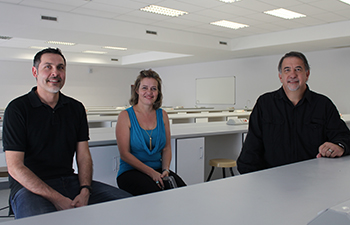Latest News Archive
Please select Category, Year, and then Month to display items
01 March 2023
|
Story Alicia Pienaar
 Prof Mathys Labuschagne is the Head of the Clinical Simulation and Skills Unit within the School of Biomedical Sciences in the Faculty of Health Sciences
Prof Mathys Labuschagne is the Head of the Clinical Simulation and Skills Unit within the School of Biomedical Sciences in the Faculty of Health Sciences
The Dean of the Faculty of Health Sciences, Prof Gert van Zyl, invites you to the inaugural lecture of Prof Mathys Labuschagne, Head of the Clinical Simulation and Skills Unit within the School of Biomedical Sciences in the Faculty of Health Sciences.
Subject: Clinical Simulation: Quo Vadis?
Venue: Auditorium, Equitas Building, Bloemfontein Campus
Date: 8 March 2023
Time: 17:30
RSVP on or before Friday 3 March 2023
Light refreshments will be served after the inaugural lecture.
About Prof M Labuschagne
Prof Mathys Labuschagne is the Head of the Clinical Simulation and Skills Unit within the School of Biomedical Sciences in the Faculty of Health Sciences at the University of the Free State. He completed his MB ChB degree and qualified as an ophthalmologist in 2006.
He developed an interest in health professions education and obtained a PhD in Health Professions Education in June 2012. The title of his thesis was: Clinical Simulation to enhance undergraduate medical education and training at the University of the Free State.
Prof Labuschagne was appointed Head of the Clinical Simulation and Skills Unit at the University of the Free State. The facility is utilised for undergraduate and postgraduate clinical simulation training, as well as interprofessional training and research. He has a special interest in simulation as training tool, precision skills training, and mastery of learning and simulation as tool to prepare students for interprofessional education and collaborative practice.
Prof Labuschagne is part of a multi-institutional consortium that developed the MySkills Medic app. It is a clinical procedural skills application aimed at graduating medical students, interns, and community-service doctors. He was appointed as a member of the Ophthalmology Foundation Education Simulation Subcommittee (affiliate of the International Council of Ophthalmology) tasked with developing a white paper to guide simulation training for ophthalmologists. He is involved in postgraduate supervision for master’s and PhD students in HPE.
Oxford professor unlocks secrets of DNA
2017-03-31

From left are: Dr Cristian Capelli, Associate Professor
of Human Evolution at Oxford University;
Dr Karen Ehlers, Senior Lecturer and Prof Paul Grobler,
both from the Department of Genetics at the UFS.
Photo: Siobhan Canavan
Many people are interested to know more about their history and origins, and with the help of genetics, it is possible to provide more information about one’s roots.
During a lecture at the Department of Genetics at the University of the Free State (UFS), Dr Cristian Capelli, Associate Professor of Human Evolution at Oxford University in the UK, addressed staff members and students on the history of our species.
Reconstructing the history of human population
With his research, titled: People on the move: population structure and gene-flow in Southern Africa, Dr Capelli looks at reconstructing the history of human populations, focusing mainly on how the different human populations are related, as well as how they exchange genes.
He said this research could be of great significance to the medical field too. “Knowing what the genetic make-up of individuals is, can give us some information about their susceptibility to diseases, or how they would react to a given medicine. Therefore, this knowledge can be used to inform health-related policies.”
Combining individual histories of multiple people
To understand this research more clearly, Dr Capelli explained it in terms of DNA and how every individual receives half of their DNA from their mother and half from their father just as their parents had received theirs from their parents. And so it goes from generation after generation. Each individual stores a part of their ancestors’ DNA which makes up the individual genetic history of each person.
“If we combine these individual histories by looking at the DNA of multiple people, we can identify the occurrences that are shared across individuals and therefore reconstruct the history of a population, and in the same way on a larger scale, the history of our own species, homo sapiens.